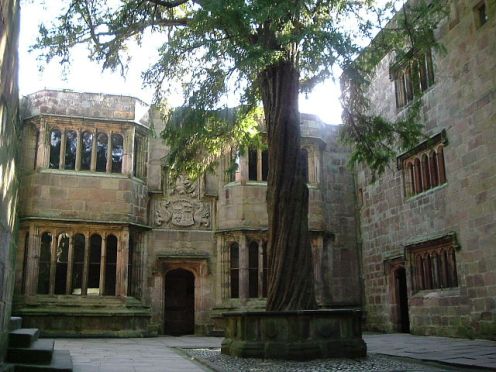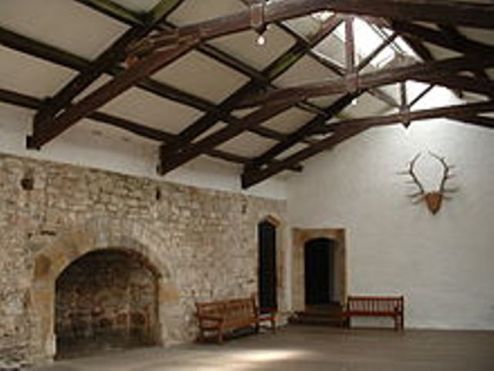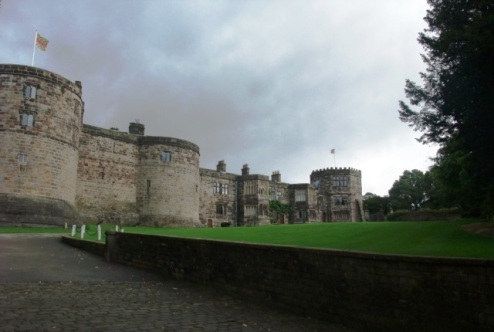While in Haworth, I decided to catch the bus to Skipton to visit the castle, seeing I’d missed it on my way through. In 1090, Robert de Romille, a Norman baron, built a fort here, but its timber ramparts were not much help against the frequent raids of rampaging Scots. He replaced it with a more formidable stone castle, setting it on top of a rocky bluff.
In 1310, the property changed hands when Edward 11 gave it to Robert Clifford, First Lord of Skipton. The gatehouse is made up of two squat towers, joined in the centre by a wall, which is topped by the Cliffords’ Norman French motto, ‘Desormais’ (Henceforth), having no doubt, some very deep meaning which escaped me.
I crossed a beautifully manicured lawn. Ahead of me, between two huge towers, were steps leading up to the entrance to the stronghold. In Norman days, visitors would have crossed a drawbridge over a moat to get this far. I so wished the moat was still there.
A metre-thick archway led into a stone-paved courtyard. The swirling shape of a yew tree, planted by Lady Clifford in 1659, held pride of place in the centre.

The castle rose all around me. Stone steps twisted away and disappeared, enticingly, behind dark doorways. I felt like I was in a production of Robin Hood. I was expecting the Sheriff of Nottingham at any minute, preferably in the guise of a leather-clad Richard Armitage, or Prince John, or maybe even a visit from Henry V111.
I chose a flight of steps and found myself in the original kitchen. Medieval kitchens would never have passed the scrutiny of today’s health inspectors. They were large, crowded, hot and smelly. Only male servants cooked and served the food which, as far as I’m concerned, is an excellent rule and wonder why it ever changed.
In an alcove jutting from the outside wall is the garderobe, in our language, the loo, very efficiently placed, as the material being disposed of dropped straight through the hole into the stream below. That must have added to the already diverse odours of the kitchen. Next to it was a chute which discharged kitchen waste in the same way.
Having just been to York, I felt like a bit of an expert on Medieval trappings. The Great Hall was typical of the time, with its hammerbeam ceiling and its enormous fireplace. It was here that Lord and Lady Clifford entertained their guests and retainers, usually at lunchtime. After this, the room was used for business and entertainment and often, at the end of the day, as sleeping quarters for the servants and the dogs.
The dungeon was created by Henry Clifford, the 10th Lord. Steps led down a narrow passageway into a dark and stuffy prison, not somewhere I’d choose for a holiday. Leg irons were used here but never torture, and one man in particular wasn’t keen to move on. At his trial in York he said he’d never been so well fed as when in the care of Lord Clifford.
I wandered through wine and beer cellars and a curing room, used for preserving meat stuffs. Fighting chambers were complete with ‘squints’, windows through which archers fired on anyone who breached the drawbridge and the gate and found themselves trapped in the courtyard.
It was an amazingly relaxed place; there seemed to be no rules. A few children ran wild around the tiny worn staircases. There were no signs forbidding entrance to any of the spaces or reminding us to be careful not to fall over, just in case we needed the warning.
Skipton Castle is spotless and amazingly well-preserved. With a bit of furniture added and a good heater, it could easily be lived in.
This is an excerpt from ‘Is This the Road to Stratford?’, the third book in my Planning to the ‘Nth’ travel series. The first, ‘The Edge of the World’ is now available as an Ebook from Amazon.
To Download a Free Sample of The Edge of the World or to Buy the Book Click Here






Amazing pic’s enjoyed the read hugs Nar xx
LikeLike
Thanks, Nar.
LikeLike
Craven – scene of my novel
LikeLike
Fantastic. It’s such an interesting area. I’m looking forward to checking out your website.
LikeLike
Reblogged this on KCJones.
LikeLike
Ah, you cant beat a good solid English castle! Yes, amazing condition! It also makes me homesick ha ha. Lovely photos btw
LikeLike
Thanks very much, Andy.
LikeLike